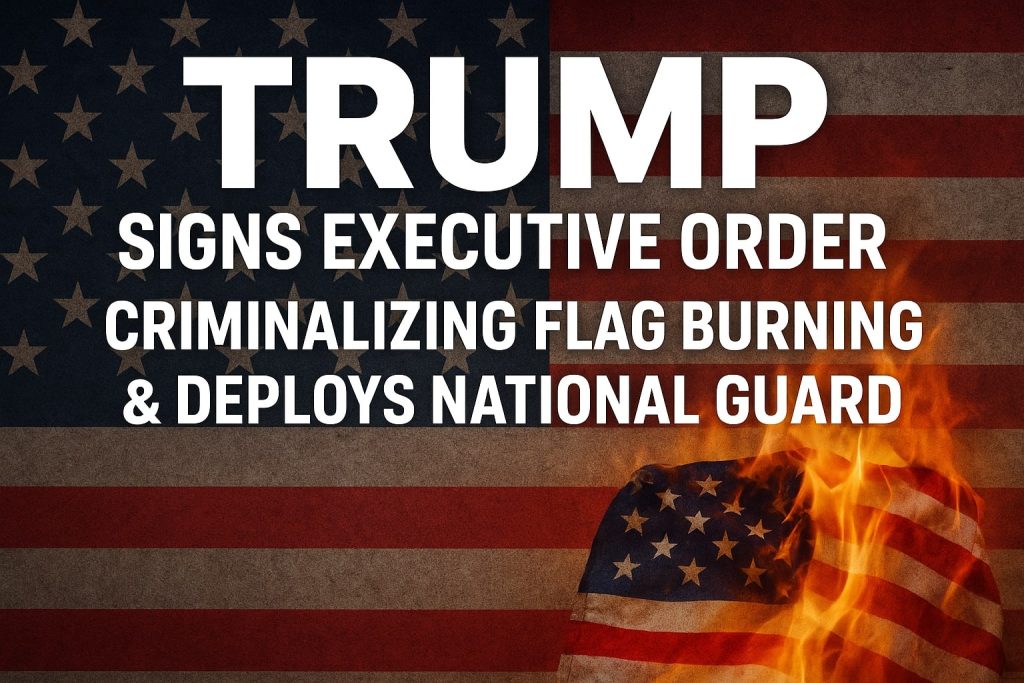
August 26, 2025 (Washington, D.C.) — In a move that sparked immediate legal and political backlash, President Donald Trump signed a sweeping executive order on August 25 directing the Justice Department to investigate and prosecute individuals who burn or desecrate the American flag—an act long held protected under the First Amendment. Simultaneously, his administration has signaled intent to deploy up to 1,700 National Guard troops across 19 states as part of a broad law-and-order initiative.
What the Executive Order Says
Trump’s order instructs Attorney General Pam Bondi to prosecute flag desecration under existing, content-neutral laws—such as disorderly conduct, property damage, or hate crimes—thus bypassing direct challenges to the Supreme Court’s 1989 decision in Texas v. Johnson, which ruled flag burning is a form of protected political expression (AP News, Reuters, The Guardian).
While the Justice Department cannot criminalize flag burning for its symbolic value alone, the order emphasizes prosecutions when such acts result in lawless behavior or disturbance. It also authorizes federal agencies—including the State Department and Homeland Security—to revoke visas, residency permits, and naturalization for foreign nationals found guilty of flag desecration (The White House, AP News, The Guardian).
Legal and Civil Liberties Under Fire
Free speech advocates and constitutional scholars condemned the order as a direct affront to First Amendment protections. Bob Corn-Revere of FIRE declared that “the government can’t prosecute protected expressive activity—even if many Americans, including the president, find it ‘uniquely offensive and provocative’” (CBS News, The Washington Post). The National Association of Criminal Defense Lawyers called it a “brazen example” of overcriminalization and executive overreach (NACDL).
Legal experts warn the order may face immediate lawsuits. One lawyer noted that while state property or safety laws can be enforced, the executive cannot override free speech protections simply because an act is offensive (The Washington Post, TIME).
Real-World Response: Flag Burning Protest Near White House
The day after the order was signed, a retired Army veteran burned a U.S. flag in Lafayette Square near the White House—declaring the order unconstitutional. He was not detained for flag burning, but for violating park regulations by setting a fire in a federal park. The incident drew sharp attention to the limits of enforcement and public resistance (The Washington Post).
Law-and-Order Push: National Guard Deployment
Parallel to the flag burn crackdown, the Trump administration is advancing a wider crackdown on urban crime by planning the deployment of up to 1,700 National Guard troops across 19 states. This follows similar moves in Los Angeles and Washington, D.C., drawing accusations of federal overreach and politicized authoritarianism (The Washington Post, Wikipedia, New York Post, Politico).
City and state leaders—particularly from Democratic-run areas—vocally opposed the plan. In Illinois, Governor JB Pritzker labeled Trump a “wannabe dictator,” while Chicago’s Mayor Brandon Johnson called mass incarceration and militarized policing “racist, immoral, and unholy” (New York Post). In Maryland, Governor Wes Moore blasted the president’s rhetoric as racially charged fearmongering and insisted local strategies should take precedence over federal troop deployments (Politico).
Why This Matters
This executive order touches on one of the nation’s core constitutional tensions: national symbolism vs. free speech. It increases the likelihood of a legal case that could return to the Supreme Court—now with a significantly more conservative bench—fueling broader implications for the interpretation of First Amendment protections (The Washington Post, Reuters).
Meanwhile, the proposed military deployments continue to challenge the balance between federal intervention and state autonomy under laws like the Posse Comitatus Act and the Insurrection Act (Wikipedia).
As debate escalates, both issues underscore the growing polarization in U.S. politics—and whether executive action or constitutional norms will prevail.
Conclusion
President Trump’s executive order is a flashpoint in the enduring dialogue about what constitutes protected speech and how far executive authority can validly extend. While supporters call it a necessary defense of national symbols, opponents warn of a dangerous precedent eroding civil liberties. Meanwhile, as National Guard deployment plans unfold, the line between public safety and militarization of domestic policy continues to be fiercely contested.
Let me know if you’d like a deeper dive into the legal implications, polling data, or historical comparisons.



